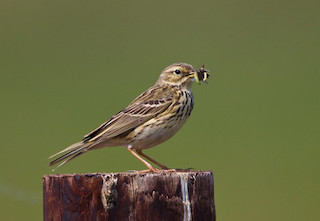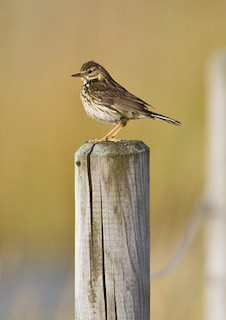 In autumn, Meadow Pipits migrate southward and to lowland areas. Watch out for them on The Lizard.
In autumn, Meadow Pipits migrate southward and to lowland areas. Watch out for them on The Lizard.
Photo: © Allan Drewitt/Natural England
Scientific name: Anthus pratensis
Other names: Hill Sparrow, Mosscheeper, Titling, Peat Lark
Conservation status: Birds of Conservation Concern review: Amber
 This small brown songbird, with its streaky plumage and the flash of white from its tail feathers in flight, is familiar in upland areas during the summer breeding season. Its distinctive piping call is heard during its characteristic upward ascent from a perch and parachuting flight downward.
This small brown songbird, with its streaky plumage and the flash of white from its tail feathers in flight, is familiar in upland areas during the summer breeding season. Its distinctive piping call is heard during its characteristic upward ascent from a perch and parachuting flight downward.
The Meadow Pipit has a wide distribution across northern Europe and Asia (and north Africa in winter), preferring open habitats such as heaths, bogs and rough grassland, as well as saltmarshes and the coast in winter. The bird is resident in Britain but is also migratory, moving south in the winter to more lowland and coastal areas in southern Britain and Europe. While it therefore breeds on The Lizard in summer, more birds arrive in the autumn, either to stay, often forming small flocks, or to head over to the continent.
Its main food source is small invertebrates, supplemented by seeds and berries in winter. A ground-nesting bird, it makes a cup-shaped nest hidden in vegetation and generally producing two clutches of heavily brown-spotted eggs per year between April and June.
Its appearance is very similar to its close relative, the Tree Pipit, a summer visitor to Britain. The Meadow Pipit has heavier streaking, and a much longer hind claw.
Like songbirds more generally, Meadow Pipit numbers are declining, thought to be because agricultural intensification has reduced suitable habitat. It is therefore an Amber list species under the UK Birds of Concervation Concern review.
 Did you know…?
Did you know…?
…The name ‘pipit’ is based on the sound of the call of birds in this genus
…Cuckoos often parasitize Meadow Pipit broods
More information and references:
Gooders, J. and Harris, A., 1986. Field Guide to the Birds of Britain and Ireland. Kingfisher Books, London.
Published: November 2013
Author: Amanda Scott
Photos: © Allan Drewitt/Natural England
